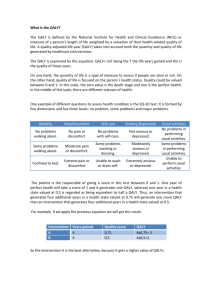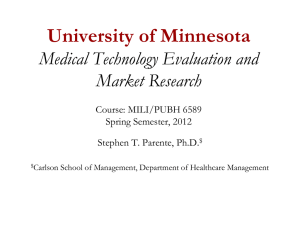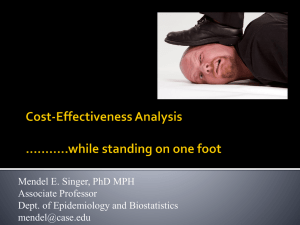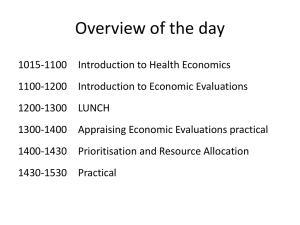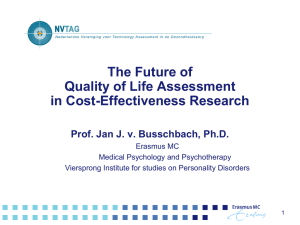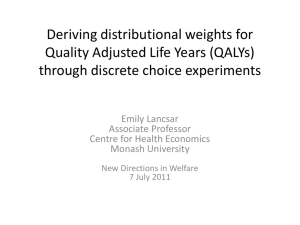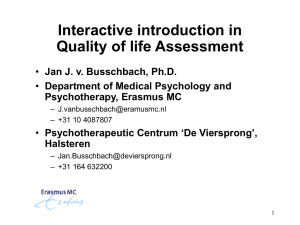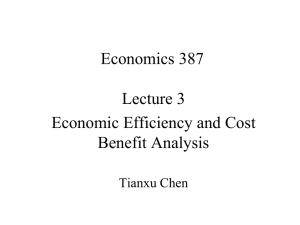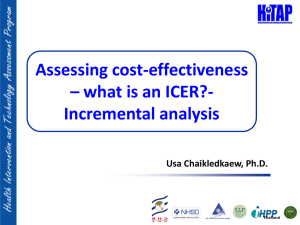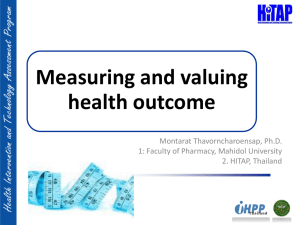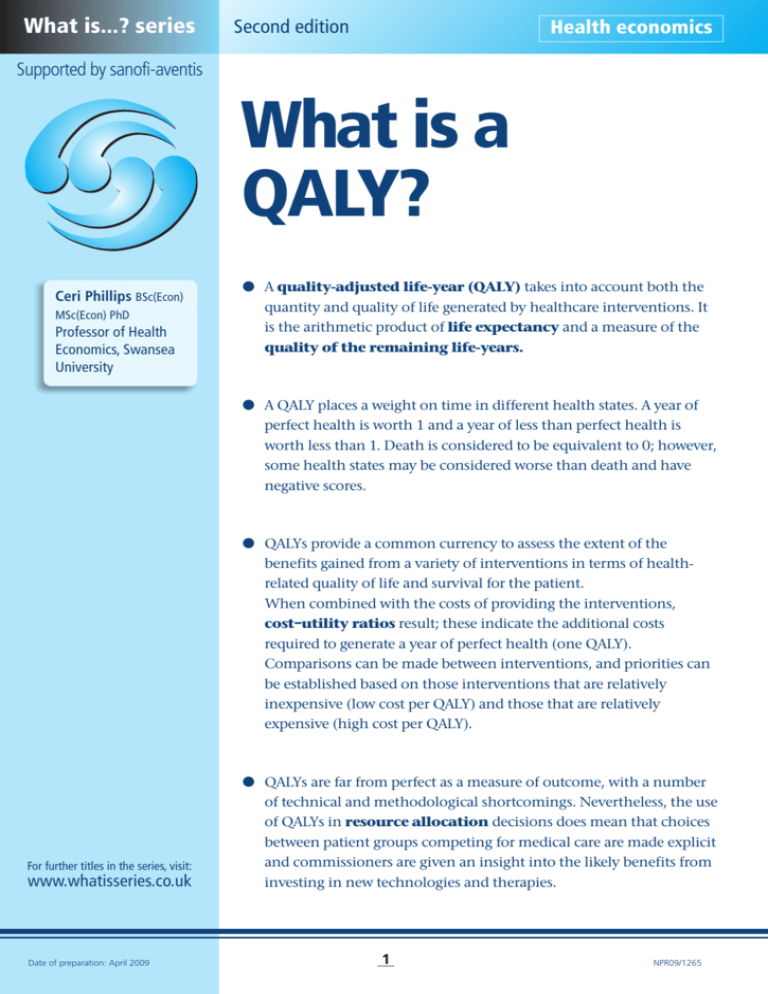
What is...? series
Second edition
Health economics
Supported by sanofi-aventis
What is a
QALY?
Ceri Phillips BSc(Econ)
MSc(Econ) PhD
Professor of Health
Economics, Swansea
University
● A quality-adjusted life-year (QALY) takes into account both the
quantity and quality of life generated by healthcare interventions. It
is the arithmetic product of life expectancy and a measure of the
quality of the remaining life-years.
● A QALY places a weight on time in different health states. A year of
perfect health is worth 1 and a year of less than perfect health is
worth less than 1. Death is considered to be equivalent to 0; however,
some health states may be considered worse than death and have
negative scores.
● QALYs provide a common currency to assess the extent of the
benefits gained from a variety of interventions in terms of healthrelated quality of life and survival for the patient.
When combined with the costs of providing the interventions,
cost–utility ratios result; these indicate the additional costs
required to generate a year of perfect health (one QALY).
Comparisons can be made between interventions, and priorities can
be established based on those interventions that are relatively
inexpensive (low cost per QALY) and those that are relatively
expensive (high cost per QALY).
For further titles in the series, visit:
www.whatisseries.co.uk
Date of preparation: April 2009
● QALYs are far from perfect as a measure of outcome, with a number
of technical and methodological shortcomings. Nevertheless, the use
of QALYs in resource allocation decisions does mean that choices
between patient groups competing for medical care are made explicit
and commissioners are given an insight into the likely benefits from
investing in new technologies and therapies.
1
NPR09/1265
What is
a QALY?
What is a QALY?
What is the concept
behind QALYs?
The outcomes from treatments and other
health-influencing activities have two basic
components – the quantity and the quality of
life. A QALY is the acronym for a qualityadjusted life-year, which embraces both of
these components and is the arithmetic
product of life expectancy and a measure of
the quality of the remaining life-years. The
National Institute for Health and Clinical
Excellence (NICE) defines the QALY as a
‘measure of a person’s length of life weighted
by a valuation of their health-related quality
of life’.1
The QALY provides a common currency for
measuring the extent of health gain that
results from healthcare interventions and,
when combined with the costs associated with
the interventions, can be used to assess their
relative worth from an economic perspective.
The quantity of life, expressed in terms
of survival or life expectancy, is a traditional
measure that is widely accepted and has few
problems of comparison – people are either
alive or not.
Quality of life, on the other hand,
embraces a whole range of different facets of
people’s lives, not just their health status. Even
restricting the focus to a person’s health-related
quality of life will result in a number of
dimensions relating to both physical and
1
Best possible health state
+
0
Death
–
Figure 1. Health state
valuations
Date of preparation: April 2009
Worst possible health state
2
mental capacity. A number of approaches have
been used to generate these quality of life
valuations, referred to as health utilities; for
example, standard gamble, time trade-off and
the use of rating scales (see What are health
utilities? for a more detailed explanation of
health utilities).2 The utilities that are produced
represent the valuations attached to each
health state on a continuum between 0 and 1,
where 0 is equivalent to being dead and 1
represents the best possible health state,
although some health states are regarded as
being worse than death and have negative
Box 1. Using the EQ-5D3
Scores for the EQ-5D are generated from the
ability of the individual to function in five
dimensions.
● Mobility
1. No problems walking about.
2. Some problems walking about.
3. Confined to bed.
● Pain/discomfort
1. No pain or discomfort.
2. Moderate pain or discomfort.
3. Extreme pain or discomfort.
● Self-care
1. No problems with self-care.
2. Some problems washing or dressing.
3. Unable to wash or dress self.
● Anxiety/depression
1. Not anxious or depressed.
2. Moderately anxious or depressed.
3. Extremely anxious or depressed.
● Usual activities
(work, study, housework, leisure
activities)
1. No problems in performing usual
activities.
2. Some problems in performing usual
activities.
3. Unable to perform usual activities.
Each of the five dimensions used has three
levels – no problem, some problems and
major problems – making a total of 243
possible health states, to which
‘unconscious’ and ‘dead’ are added to make
245 in total.
NPR09/1265
What is
a QALY?
valuations (Figure 1). The preferred instrument
for the measurement and valuation of healthrelated quality of life in NICE appraisals is the
EQ-5D, which is shown in Box 13 (see What is
quality of life? for more information on healthrelated quality of life and the EQ-5D).4
The EQ-5D is widely used and has been
validated in many different patient
populations. It has been designed so that
people can describe the extent to which they
have a problem in each of the five
dimensions of health: mobility, ability to selfcare, ability to undertake usual activities, pain
and discomfort, and anxiety and depression.
For each of the possible 245 health states,
utility scores were constructed from responses
from a random sample of 3,000 people in the
UK, using a choice-based method of valuation
(the time trade-off method). Examples of the
utilities of some of the health states are
shown in Table 1.
KEY FORMULA 1
Calculating QALYs: an example
Intervention A: four years in health state 0.75
3 QALYs
Intervention B: four years in health state 0.5
2 QALYs
Additional number of QALYs generated by A
1 QALY
If the EQ-5D instrument has not been
used, mapping of utility scores from other
health-related quality of life measures that
were included in the relevant clinical trial(s)
can be employed, or other standardised and
validated measures (for example, SF-6D,
Health Utilities Index) included in the
relevant clinical trial(s) may be used.
How are QALYs arrived at?
The basic idea of a QALY is straightforward.
The amount of time spent in a health state is
weighted by the utility score given to that
health state. It takes one year of perfect health
(utility score of 1) to generate one QALY,
whereas one year in a health state valued at
0.5 is regarded as being equivalent to half a
QALY. Thus, an intervention that generates
four additional years in a health state valued
at 0.75 will generate one more QALY than an
intervention that generates four additional
years in a health state valued at 0.5
(Key formula 1).
Effect of interventions
When data relating to both health-related
quality of life and survival are available, it is
then possible to chart the impact of a
healthcare intervention on an individual
patient. For example, it is possible to compare
Table 1. EQ-5D health state valuations
Health state
Description
11111
No problems
1.000
11221
No problems walking about; no problems with self-care; some problems with
performing usual activities; some pain or discomfort; not anxious or depressed
0.760
22222
Some problems walking about; some problems washing or dressing self;
some problems with performing usual activities; moderate pain or discomfort;
moderately anxious or depressed
0.516
12321
No problems walking about; some problems washing or dressing self; unable
to perform usual activities; some pain or discomfort; not anxious or depressed
0.329
21123
Some problems walking about; no problems with self-care; no problems
with performing usual activities; moderate pain or discomfort; extremely
anxious or depressed
0.222
23322
Some problems walking about, unable to wash or dress self, unable to perform
usual activities, moderate pain or discomfort, moderately anxious or depressed
0.079
33332
Confined to bed; unable to wash or dress self; unable to perform usual
activities; extreme pain or discomfort; moderately anxious or depressed
Date of preparation: April 2009
Valuation
3
–0.429
NPR09/1265
What is
a QALY?
the health profile of a patient receiving an
intervention with that of a patient who does
not receive the intervention.
Figure 2a shows a situation where one
treatment provides a consistently greater area
under the QALY–time curve than another
treatment. Figure 2b presents a comparison
between the treatment and non-treatment of
a condition with a poor prognosis. As shown,
the treatment has an initial improvement on
health-related quality of life, but, as adverse
effects associated with the treatment become
apparent, this benefit is lost and quality of life
falls below that expected for a non-treated
patient. This quality of life deficit associated
with the treatment generates ‘QALYs lost’
compared with a non-treated patient. At a
point in time when the latter patient dies, the
treated patient demonstrates ‘QALYs gained’
KEY FORMULA 2
Cost–utility ratio – an example
Cost of Intervention A – Cost of Intervention B
Cost–utility ratio =
2a
No. of QALYs produced by Intervention A
– No. of QALYs produced by Intervention B
2b
1
Quality
of life
weights
Intervention A
1
Quality
of life
weights
by virtue of their continued life, albeit at a
lower quality of life. Given the difference in
survival, the issue then becomes one of
‘deciding’ between a longer survival time
with a reduced health-related quality of life
and a shorter survival time with a better
health-related quality of life.
Using QALYs – an example
QALYs provide a common currency to assess
the extent of the benefits gained from a
variety of interventions in terms of healthrelated quality of life and survival for the
patient. They are used to assess the
effectiveness of interventions and are
combined with the costs incurred in
providing the interventions to generate
cost–utility ratios. A cost–utility ratio is the
difference between the costs of two
interventions divided by the difference in the
QALYs they produce (Key formula 2).
A recent example of this can be found in
the assessments by the Scottish Medicines
Consortium5 and All Wales Medicines
Strategy Group6 of docetaxel (Taxotere®,
sanofi-aventis) in combination with cisplatin
and 5-fluorouracil (5-FU) for the induction
treatment of patients with resectable locally
advanced squamous cell carcinoma of the
QALYs
gained
No intervention
QALYs lost
QALYs gained
Intervention
QALYs
gained
Intervention B
0
Death 1
0
Death 2
Time
Death 1
Death 2
Time
Figure 2a. Comparison of two different treatments. Figure 2b. Comparison between treatment and non-treatment of a
condition with a poor prognosis
Date of preparation: April 2009
4
NPR09/1265
What is
a QALY?
head and neck. Here, the addition of
docetaxel to cisplatin and 5-FU compared
with the use of cisplatin and 5-FU alone
produces an additional 2.08 QALYs at an
additional cost of £3,824 per patient, which
means that it costs £1,832 (£3,824/2.08) to
generate an additional QALY by using
docetaxel in combination with cisplatin and
5-FU. Further analysis shows that there is a
95% probability that the docetaxel-based
induction therapy regimen is cost-effective
compared with the standard induction
therapy at a willingness to pay of
£20,000/QALY.6
Limitations of QALYs
While QALYs provide an indication of the
benefits gained from a variety of medical
procedures, in terms of quality of life and
survival for patients, they are far from perfect
as a measure of outcome. For example, the
use of QALYs as a single outcome measure for
economic evaluation means that important
health consequences are excluded. QALYs also
suffer from a lack of sensitivity when
comparing the efficacy of two competing but
similar drugs and in the treatment of less
severe health problems.
Chronic diseases, where quality of life is a
major issue and survival less of an issue, are
difficult to accommodate in the QALY
context, and there is a tendency to resort to
the use of disease-specific measures of
quality of life. Similarly, preventive measures,
where the impact on health outcomes may
not occur for many years, may be difficult to
quantify using QALYs because the importance
attached to each of the health dimensions is
highly dependent on age, life context and life
responsibilities. For example, it is very
difficult to compare the health status of a
potential Olympic champion who suffers a
hamstring twinge in the warm-up session
with that of an elderly person who has been
restored to some measure of mobility as a
result of an intervention.
Further criticisms have surrounded the
inadequate weight attached to emotional and
mental health problems, and the lack of
consideration of the impact of health
problems on the quality of life of carers and
other family members, while much debate
Date of preparation: April 2009
5
surrounds who should be involved in placing
values on health states.7,8
Discussion has also focused on how much
society should be prepared to pay for a QALY.
While there is a degree of consensus that it
should generally be between £20,000 and
£30,000, considerable debate has arisen in
relation to, for example, treatments used at
the end of life or for ultra-orphan conditions,
where higher thresholds have been advocated
and used.
Nevertheless, the use of QALYs in resource
allocation decisions does mean that choices
between patient groups competing for
medical care are made explicit.
Commissioners are increasingly faced with
resource constraints and have to prioritise
their expenditure against an incessant flow of
new technologies and therapies that all claim
to enhance the health status of particular
patient groups. QALYs and cost–utility
analysis provide additional information for
decision-makers as they grapple with
addressing the healthcare dilemma of where
to allocate resources to generate the
maximum health benefits for their
communities and society as a whole.
References
1. National Institute for Health and Clinical Excellence.
Guide to the methods of technology appraisal.
www.nice.org.uk/media/B52/A7/TAMethodsGuideUpdat
edJune2008.pdf (last accessed 10 March 2009)
2. Tolley K. What are health utilities? London: Hayward
Medical Communications, 2009.
3. www.euroqol.org/home.html (last accessed 24 March
2009)
4. Fallowfield L. What is quality of life? London: Hayward
Medical Communications, 2009.
5. Scottish Medicines Consortium. Docetaxel 20 and 80mg
concentrate and solvent for solution for infusion (Taxotere®).
No. (481/08).
www.scottishmedicines.org.uk/smc/files/docetaxel%20(T
axotere)%20%20FINAL%20JUNE%202008%20for%20we
bsite.pdf (last accessed 10 March 2009)
6. All Wales Medicines Strategy Group. Final Appraisal
Report: Docetaxel (Taxotere®) for locally advanced squamous
cell carcinoma of the head and neck. Advice No: 1008.
www.wales.nhs.uk/sites3/Documents/371/docetaxel%20
Taxotere%20FAR.pdf (last accessed 10 March 2009)
7. Nord E, Pinto JL, Richardson J, Menzel P, Ubel P.
Incorporating societal concerns for fairness in numerical
valuations of health programmes. Health Econ 1999; 8:
25–39.
8. Coast J. Is economic evaluation in touch with society’s
health values? BMJ 2004; 329: 1233–1236.
Further reading
1. Drummond MF, Sculpher MJ, Torrance GW, O’Brien
BJ, Stoddart GL. Methods for the Economic Evaluation of
Health Care Programmes. Oxford: Oxford University Press,
2005.
2. Phillips CJ. Health Economics: An introduction for health
professionals. Oxford: Blackwell Publishing, 2005.
3. National Institute for Health and Clinical Excellence.
Social Value Judgements: Principles for the development of
NICE guidance.
www.nice.org.uk/media/C18/30/SVJ2PUBLICATION2008
.pdf (last accessed 14 April 2009)
NPR09/1265
What is...? series
What is
a QALY?
First edition published 2001
Authors: Ceri Phillips and
Guy Thompson
This publication, along with
the others in the series, is
available on the internet at
www.whatisseries.co.uk
The data, opinions and statements
appearing in the article(s) herein
are those of the contributor(s)
concerned. Accordingly, the
sponsor and publisher, and their
respective employees, officers
and agents, accept no liability
for the consequences of any such
inaccurate or misleading data,
opinion or statement.
Published by Hayward Medical
Communications, a division of
Hayward Group Ltd.
Copyright © 2009 Hayward
Group Ltd.
All rights reserved.
Supported by sanofi-aventis
Date of preparation: April 2009
6
NPR09/1265

